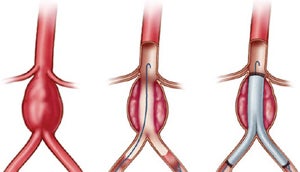Abdominal Aortic Aneurysm
It’s frightening but true: Approximately 80 percent of individuals who suffer a ruptured abdominal aortic aneurysm (AAA) die before they can receive treatment. But, when AAAs are detected early (and they often are), repairing such a potentially life-threatening condition can be quite uncomplicated for patients.
The large blood vessel that supplies blood to the legs and abdomen is called the aorta. An AAA occurs when a section of the aorta balloons out.
AAAs typically take many years to expand and rarely cause symptoms. AAAs are typically found incidentally during an X-ray, ultrasound or CT scan performed for some unrelated reason. Occasionally, an aneurysm is first suspected during a regular exam with your primary care physician.
During the exam, the doctor may notice a lump, a pulsation or rigidity in the abdomen and order an ultrasound of the abdomen to confirm an AAA is present. If an AAA is detected, a CT scan will then help the physician determine the size of the aneurysm and the best treatment strategy.
AAA Risk Factors
AAAs can develop in people of all ages and genders, but they are most prevalent in men older than 60. Other AAA risk factors include:
- Emphysema
- Genetic factors
- High blood pressure
- High cholesterol
- Smoking
- Obesity

To perform the procedure, cardiologist working in conjunction with a vascular surgeon, makes a small incision in the patient’s groin area and threads a catheter through the femoral artery and into the aorta to the site of the aneurysm. Attached to the catheter is an endograft, a fabric covered metal stent. Once the endograft reaches the aneurysm, the endograft is released to protect the aneurysm from rupture.